Indonesia Flexible Packaging Market Size
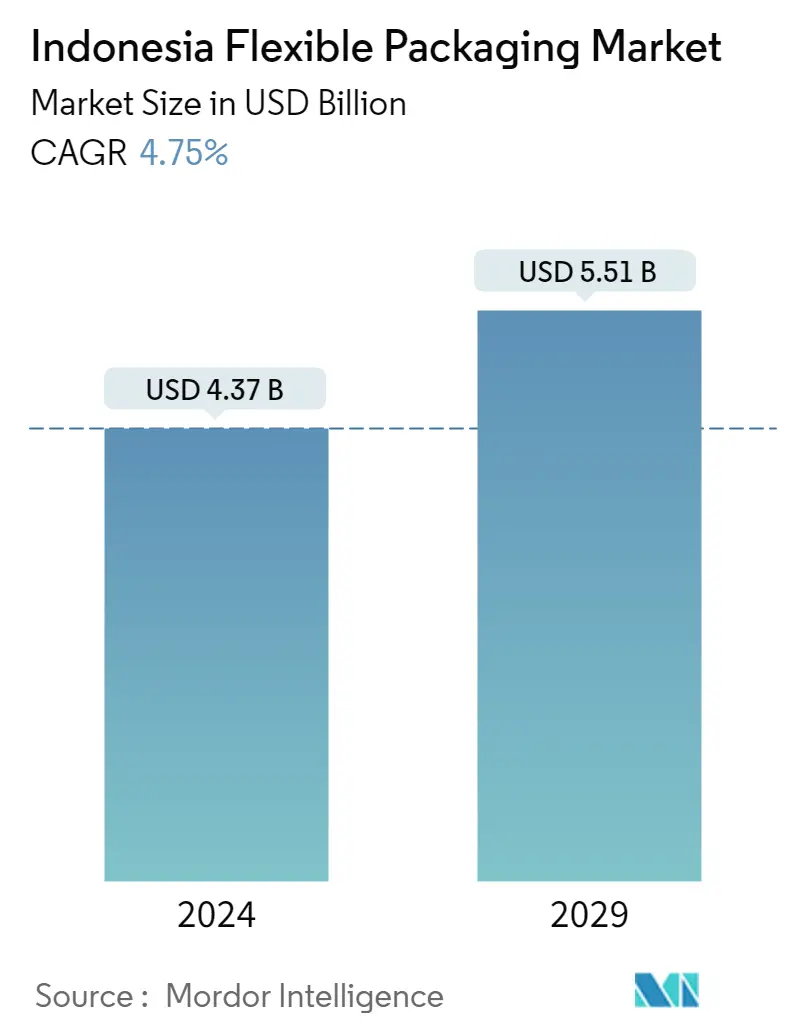
| Study Period | 2019 - 2029 |
| Base Year For Estimation | 2023 |
| Market Size (2024) | USD 4.37 Billion |
| Market Size (2029) | USD 5.51 Billion |
| CAGR (2024 - 2029) | 4.75 % |
| Market Concentration | Low |
Major Players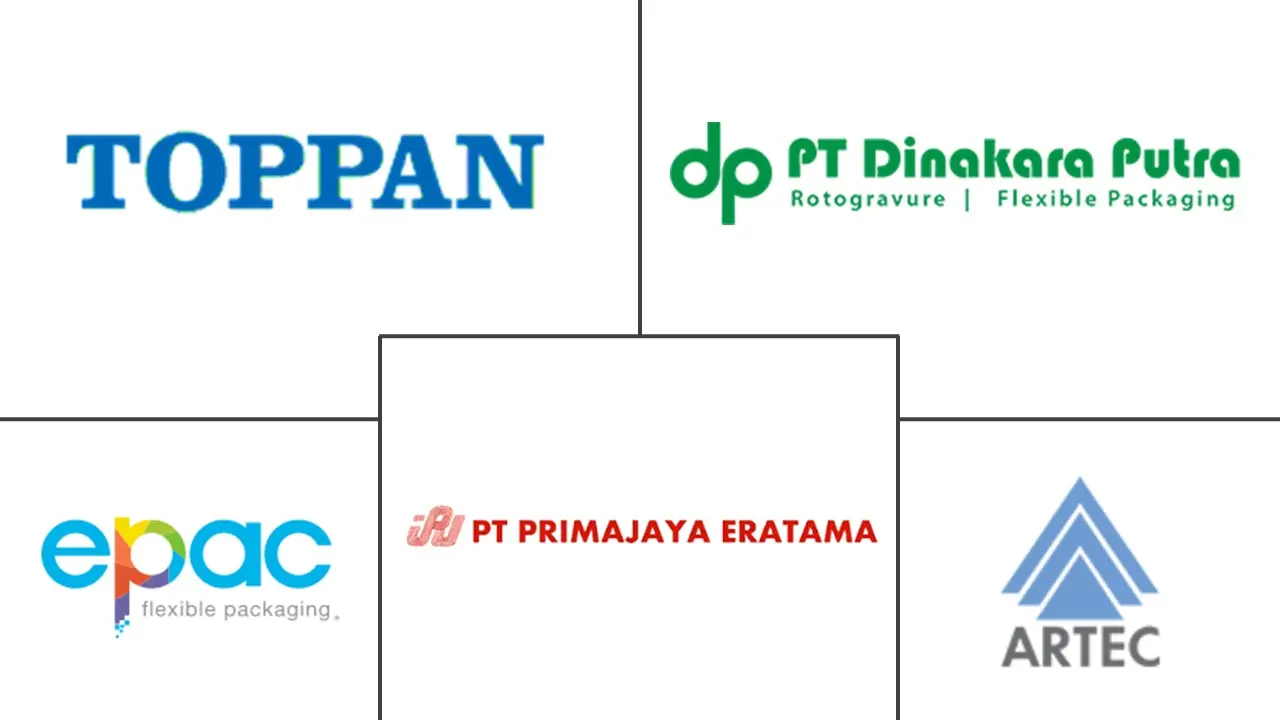
*Disclaimer: Major Players sorted in no particular order |
Indonesia Flexible Packaging Market Analysis
The Indonesia Flexible Packaging Market size is estimated at USD 4.37 billion in 2024, and is expected to reach USD 5.51 billion by 2029, growing at a CAGR of 4.75% during the forecast period (2024-2029).
Flexible packaging allows more economical and customizable options for packaging products. Flexible packaging products are beneficial in industries that require versatile packaging, such as the food and beverage, personal care, and pharmaceutical industries. It has grown popular due to its high efficiency and cost-effectiveness.
- The flexible packaging industry of Indonesia plays a pivotal role as the country moves towards sustainability with a gradual shift in focus from single-layer plastic films to multilayer, high-barrier, recyclable packaging material. The industry is primarily driven by the country's increasing population and high demand for low-cost, flexible packaging.
- Demand for flexible packaging in the country has been significantly influenced by the local food, beverage, and pharmaceutical industries. Indonesia's food and beverage industry substantially contribute to its overall growth. The sector has witnessed a rapid increase in revenue which was challenged during the pandemic but is expected to recover rapidly over the forecast period maintaining the demand for flexible packaging formats from the food and beverage industry.
- Economic growth and greater demand for single-serve, on-the-go convenience foods in Indonesia have fueled an increase in flexible packaging production. In response, vendors in the market are investing in capacity expansion. The fast-growing Indonesian flexible packaging manufacturer Putra Naga Indotama is investing in new, state-of-the-art machinery as a part of a growth strategy to increase business with existing and new customers.
- Various industries use plastic packaging solutions, including manufacturing, retail, and healthcare. Due to its high barrier qualities, lengthy shelf life, and durability, plastic packaging has seen substantial growth in the healthcare sector. But the increasing awareness about the environmental effect of single-use plastic and unsustainable business practices has empowered consumers to demand a higher standard of product that has a positive impact ecologically. This is expected to hinder the market's growth.
- Indonesia is a promising e-commerce market in the Asia-Pacific, with several local and global players competing. The pervasiveness of the internet, increasing digitization, growing tourism, and the proliferation of websites are driving the growth of e-commerce. The COVID-19 pandemic further accelerated e-commerce sales in Indonesia. Moreover, flexible packaging may expect growth in the market studied with the increasing demand for medical and healthcare supplies. Over the forecast period, industrial activity is likely to improve when the global economy begins to recover from the pandemic, which is currently happening.
Indonesia Flexible Packaging Market Trends
This section covers the major market trends shaping the Indonesia Flexible Packaging Market according to our research experts:
Packaging Films to Witness Significant Growth
- Polyethylene thermoplastics manufactured from petroleum include high-density polyethylene (HDPE) and polyethylene high-density (PEHD). Due to its exceptional versatility, HDPE is the most extensively used plastic. Beverage bottles, cosmetics like shampoo, and home goods are among the common uses for HDPE. HDPE makes cereal box liners and the thin plastic vegetable bags found in grocery stores and on bread. Such significant material characteristics create the demand for PE products and contribute considerably to flexible packaging in the country.
- BoPET film possesses good stiffness, a smooth surface, and good chemical and abrasion resistance. Thus, they are preferred for easy processing and achieving an ideal oxygen barrier. BoPET-primed films achieve improved adhesions with ink, adhesive, and aluminum metallization.
- In addition, these films find their applications in multiple industries, such as sustainable energy, healthcare and hygiene, food and beverage, automotive, consumer electronics, and more. Among these end-user industries, it is widely used as a surface film in laminations by the packaging industry as it helps protect food against oxidation and maintains a longer shelf life.
- BOPP films are transparent Biaxially oriented polypropylene films designed to offer high performance, attractive aesthetics, and ease of conversion for flexible packaging and other applications. These films possess numerous properties, such as high tensile strength and improved stiffness, lower elongation, higher tensile strength, better gas barrier, and lower haze than CPP. Also, BOPP films are significantly adopted for packing food materials due to stringent food packaging requirements. The package helps protect the nutritional properties of the food until final consumption.
- Polyvinyl Chloride (PVC) films are thin thermoplastic films in rigid and flexible forms with good cling, clarity, and puncture-resistant properties. Depending on the requirements of the applications, it could demonstrate rigidity or flexibility and feature a transparent, colored, and glossy finish. Due to their versatile nature, these films use in pharmaceutical and food and beverage packaging. Moreover, the consumption of flexible PVC films has increased due to their demand as a clung wrap for food service, vacuum packaging for meat and pre-cooked meals, and shrink sleeves because of their strength, transparency, processability, and low raw material cost.
- About benefits, the PVC films do not affect the packaged food, guard against contamination by preventing transmission of germs during distribution when used as cling films, and oxygen and water barrier qualities that help extend the food shelf life are preferred in the food packaging industry.
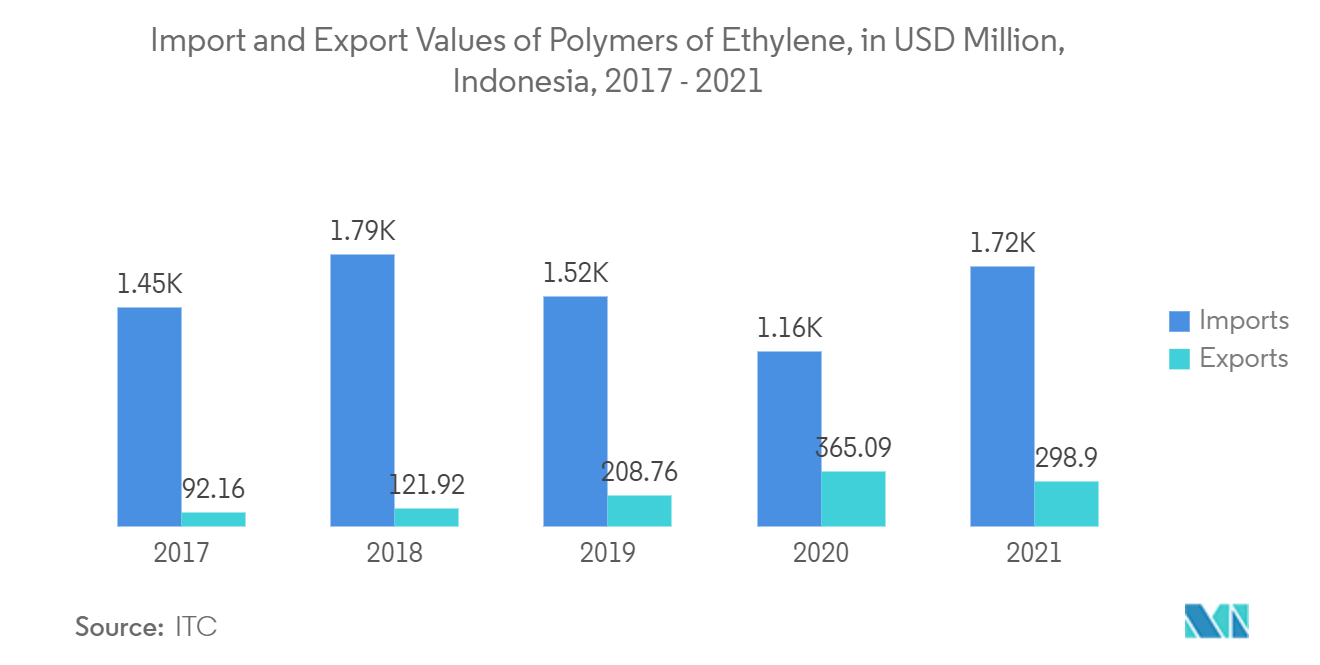
Food Industry Holds Major Market Share
- The COVID-19 pandemic-related market volatility generated logistical challenges throughout 2021 that hampered the need for packaging materials. However, Indonesia's packaging sector experienced a crucial market and has shown major developments in flexible packaging for food in the last few years. This may be seen in the growth of e-commerce, which necessitates unique shipping packaging. Additionally, there has been an upsurge in frozen foods with longer expiration dates.
- The demand for flexible packaging solutions is mainly driven by millennial customers in Indonesia, as they prefer single-serving and on-the-go food. As these products are primarily designed to be portable, durable, and lightweight, flexible packaging is a well-suited option to pack such products.
- Increased spending on bakery and cereal bars, short-run ready meals and coffee or hot chocolate sticks and pouches, dehydrated and dry foods (instant soup, gravy and sauce packets, rice, and food mixes), snack foods and nuts, spice foods, chocolates and sweets, ice-cream novelties, and bakery products, such as cookies (biscuits), cakes, and chips, have increased considerably in Indonesia during the past few years.
- Flexible packaging goods, such as stand-up gusseted and pillow pouches, are commonly used in the food industry. Pillow pouches have also seen significant growth as their use in the food, beverage, and dairy industries have increased. Some essential qualities that positively influence product penetration are low cost, good sealing ability, and cost-effective transportation.
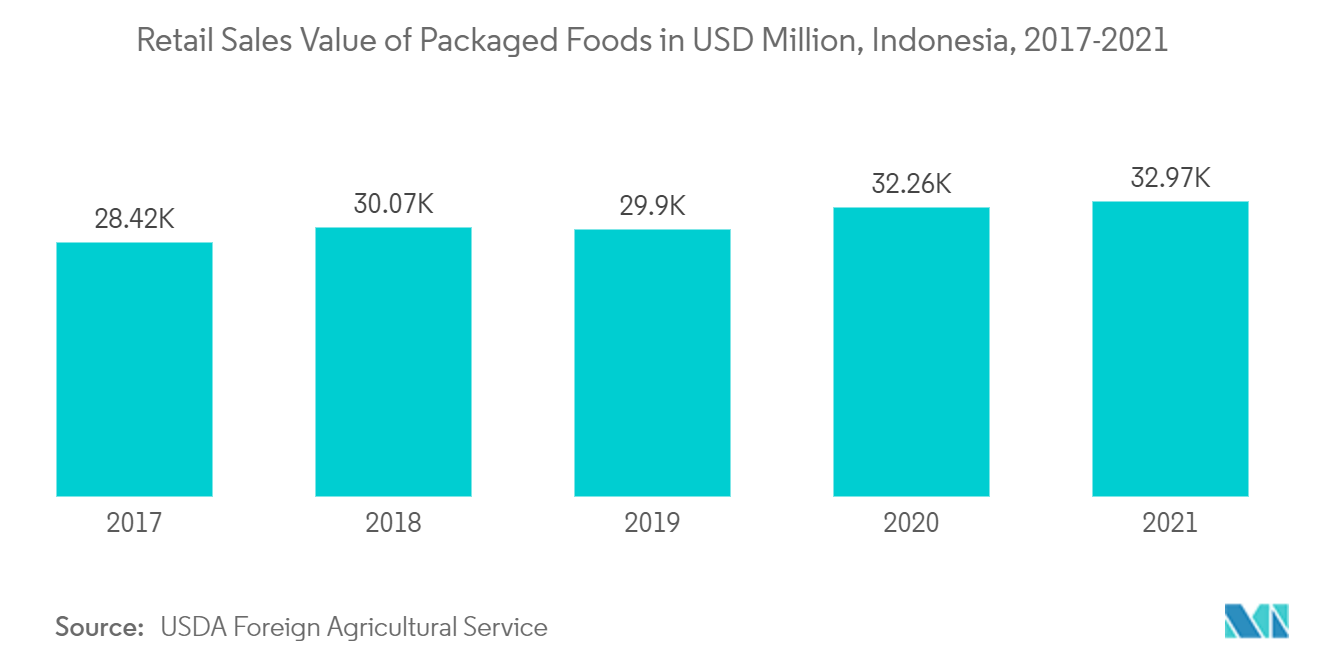
Indonesia Flexible Packaging Industry Overview
The firm concentration ratio is expected to record higher growth during the forecast period as several players look at this market as a lucrative opportunity to consolidate their product offerings. The firm concentration ratio is expected to grow considerably over the forecast period. However, short product development cycles and relatively high exit barriers affect firms in this market. Overall, the competitive rivalry is expected to be high.
- In October 2022, PT ePacFlexible Packaging announced the offering of flat-bottom pouch packaging in addition to its extensive line of flexible pouch offerings. The company is extending its partnership with the industry-leading pouch equipment manufacturer, Totani, to bring its customers the highest quality finished products.
- In June 2022, PT Trias Sentosa Tbk (TRST), a prominent packaging manufacturer, announced that Biaxially orientated polypropylene (BOPP) and cast polypropylene (CPP), two new machines to be operational in the fourth quarter of 2022. TRST is expecting the year's sales to improve due to the inclusion of the new machine. A total investment value of USD 40 million and USD 8 million, respectively, is assigned to each of them. According to the corporation, there would be an additional 30,000 tonnes of output each year connected to BOPP. Meanwhile, the CPP engine will boost output by around 15,000 tonnes annually. The expanded production capacity totals 45,000 tonnes per year and is expected to begin operations in the fourth quarter of 2022.
Indonesia Flexible Packaging Market Leaders
-
PrimaJaya Eratama
-
PT ePac Flexibles Indonesia
-
PT Indonesia Toppan Group
-
PT Dinakara Putra
-
PT Artec Package Indonesia
*Disclaimer: Major Players sorted in no particular order
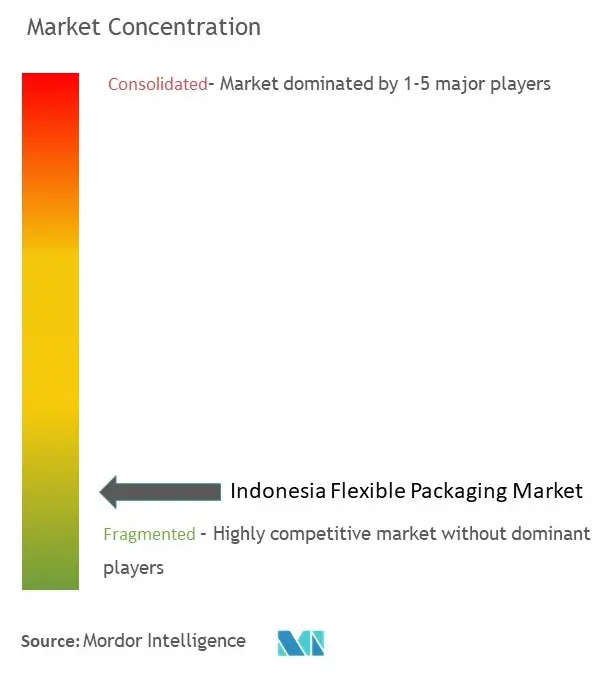
Indonesia Flexible Packaging Market News
- September 2022 - Toyobo, a Japanese textile and fiber manufacturer, announced plans to build a polyester packaging film factory in Indonesia. To address the rising demand for environmentally friendly film products, the factory will be situated at Pt Trias Toyobo Astria (TTA), a joint venture (JV) established by Toyobo and Indonesian (plastic) filmmaker PT Trias Sentosa (Trias). The project will receive an investment from Toyobo of about JPY 10 billion (USD 71 million), and work is expected to start in early 2024. According to the firm, the investment will increase TTA's production capacity and is anticipated to be operational by late 2025.
- May 2022 - Lamipak, one of the industry leaders in providing high-quality products and solutions in aseptic packaging, invested GBP 160 million (USD 193.04 million) to construct a new Indonesian packaging factory, which is the second factory in Indonesia. The factory will not only be the company's first factory expansion overseas but also be the first of its kind to be producing aseptic packaging in the country.
Indonesia Flexible Packaging Market Report - Table of Contents
1. INTRODUCTION
- 1.1 Study Assumptions and Market Definition
- 1.2 Scope of the Study
2. RESEARCH METHODOLOGY
3. EXECUTIVE SUMMARY
4. MARKET INSIGHTS
- 4.1 Market Overview
- 4.2 Industry Value Chain Analysis
-
4.3 Industry Attractiveness - Porter's Five Forces Analysis
- 4.3.1 Bargaining Power of Suppliers
- 4.3.2 Bargaining Power of Buyers
- 4.3.3 Threat of New Entrants
- 4.3.4 Threat of Substitute
- 4.3.5 Intensity of Competitive Rivalry
- 4.4 Assessment of the Impact of COVID-19 on the Industry
- 4.5 Industry Regulations and Recycling Policies in Indonesia
- 4.6 Key Global Cues on Sustainability Currently Witnessed in Indonesia
5. MARKET DYNAMICS
-
5.1 Market Drivers
- 5.1.1 Shift Toward Light Weight and Smaller Pack Types to aid the Demand for Flexible Packaging
- 5.1.2 Packaging Films are Expected to Register Strong Growth in the Food and Pharmaceutical Sector
-
5.2 Market Restraints
- 5.2.1 Lack of a Defined Recycling Plans Coupled with Environmental Challenges
6. MARKET SEGMENTATION
7. By Product Type
-
7.1 Packaging Films
- 7.1.1 PE (HDPE, LDPE)
- 7.1.2 BOPET
- 7.1.3 BOPP and CPP
- 7.1.4 PVC
- 7.1.5 Other Material Types
- 7.2 Pouches (Retort, Stand-up & Flat)
- 7.3 Bags (Gusseted, Picketed)
- 7.4 Other Product Types
8. By End-user Industry
- 8.1 Food
- 8.2 Beverage
- 8.3 Pharmaceutical and Medical
- 8.4 Household and Personal Care
- 8.5 Other End-User Industries
9. COMPETITIVE LANDSCAPE
-
9.1 Company Profiles
- 9.1.1 PrimaJaya Eratama
- 9.1.2 PT ePac Flexibles Indonesia
- 9.1.3 PT Indonesia Toppan Group
- 9.1.4 PT Dinakara Putra
- 9.1.5 PT Artec Package Indonesia
- 9.1.6 Mondi Group
- 9.1.7 PT Trias Sentosa Tbk
- 9.1.8 PT Indopoly Swakarsa Industry Tbk
- 9.1.9 PT Argha Prima Industry
- 9.1.10 PT Lotte Packaging
- 9.1.11 PT Karuniatama Polypack
- 9.1.12 PT. Masplast Poly Film
- 9.1.13 PT Polidayaguna Perkasa
- *List Not Exhaustive
10. LIST OF MAJOR CUSTOMERS FOR FLEXIBLE PACKAGING IN INDONESIA
11. INVESTMENT ANALYSIS
12. FUTURE OUTLOOK OF THE MARKET
** Subject To AvailablityIndonesia Flexible Packaging Industry Segmentation
Flexible packaging is packaging or any part of a packaging whose shape can be readily changed. Some product types of flexible packaging include bags, pouches, films, wraps, etc., produced using non-rigid materials, allowing for more economical and customizable options.
The study tracks the demand for Flexible packaging products in Indonesia. The entire supply chain, from resin production to product consumption and recycling, has been studied to understand key trends, developments, the role of substitutes, etc. The critical products considered in the scope include Packaging Films (PE, BOPET, CPP & BOPP, and PVC), Bags, and Pouches, among others. The study also analyzes the significant end-users (Food, Beverage, Pharmaceutical & Medical, Household & Personal Care) of flexible packaging products in Indonesia based on the overall demand. The study further analyzes the overall impact of COVID-19 on the ecosystem. The market sizes and forecasts are provided in terms of value in USD billion for all the above segments.
Indonesia Flexible Packaging Market Research FAQs
How big is the Indonesia Flexible Packaging Market?
The Indonesia Flexible Packaging Market size is expected to reach USD 4.37 billion in 2024 and grow at a CAGR of 4.75% to reach USD 5.51 billion by 2029.
What is the current Indonesia Flexible Packaging Market size?
In 2024, the Indonesia Flexible Packaging Market size is expected to reach USD 4.37 billion.
Who are the key players in Indonesia Flexible Packaging Market?
PrimaJaya Eratama, PT ePac Flexibles Indonesia , PT Indonesia Toppan Group, PT Dinakara Putra and PT Artec Package Indonesia are the major companies operating in the Indonesia Flexible Packaging Market.
What years does this Indonesia Flexible Packaging Market cover, and what was the market size in 2023?
In 2023, the Indonesia Flexible Packaging Market size was estimated at USD 4.17 billion. The report covers the Indonesia Flexible Packaging Market historical market size for years: 2019, 2020, 2021, 2022 and 2023. The report also forecasts the Indonesia Flexible Packaging Market size for years: 2024, 2025, 2026, 2027, 2028 and 2029.
Indonesia Flexible Packaging Industry Report
The Indonesia Flexible Packaging Market is segmented by product type, including packaging films such as PE, BOPET, BOPP & CPP, and PVC, as well as pouches and bags. The market is also categorized by end-user industry, covering food, beverage, pharmaceutical & medical, and household & personal care sectors. The market size and forecasts are provided in terms of value in USD billion for all segments. This market analysis includes a forecast outlook and a historical overview.
The industry analysis reveals significant growth in the flexible packaging market, driven by increasing demand across various end-user industries. The market forecast indicates a positive outlook, with substantial market growth expected in the coming years. Industry reports highlight the market leaders and their strategies, providing valuable industry information and insights.
The industry outlook suggests that the flexible packaging market will continue to expand, supported by advancements in packaging technology and rising consumer preference for convenient and sustainable packaging solutions. Market data and industry statistics underscore the market's potential, with market predictions indicating robust growth.
Industry research and market review emphasize the importance of market segmentation in understanding the diverse needs of different end-user industries. The market value is projected to increase, reflecting the growing adoption of flexible packaging solutions. The report example and report pdf offer comprehensive insights into the market trends and industry sales.
In conclusion, the Indonesia Flexible Packaging Market is poised for significant growth, driven by favorable market conditions and increasing demand from various sectors. The market overview and industry trends provide a clear picture of the market's trajectory, making it an essential area of focus for industry stakeholders.



